Full-Color, Low-Cost 3D Holograms Are About to Become Real
No astromech droid required.

You might soon be able to to project a full color, three-dimensional hologram using nothing more complicated than a flashlight.
Researchers at the University of Utah have devised an ingenious way to make holograms larger, brighter, and more colorful without using the complicated and expensive set of lasers necessary for feats like resurrecting Tupac Shakur or the Notorious B.I.G.. The electrical and computer engineering researchers published their research in the journal Scientific Reports on Wednesday.
Traditional holograms usually need sophisticated lasers and a massive amount of light to project an image. They’re inefficient because shining white light on something only reflects the color of that object, while the rest of the visual spectrum gets wasted. This newly devised technique fixes that problem, and it’s completely wild.
Lead researcher Rajesh Menon and his team adapted a principle found in the wings of certain iridescent butterflies. The wings reflect nearly all of the white light shone on them, redirecting it so someone looking at it can see different colors on the spectrum on different parts of the wing. The new hologram technology uses a sophisticated algorithm to harness this principle, displaying a much brighter and more colorful hologram that’s visible from wider angles. That distinguishes it from current holograms, which are only visible from the right angle.
The best part, he says, is that the whole thing is cheap, and requires a whole lot less light.
“Projecting an image before was very inefficient, and you need a massive lamp,” Menon said in a statement. “Here, you can just do it with just a piece of plastic and a flashlight. It’s much simpler and more efficient this way.”
Only a team of scientists could take an exciting technology and make it look as blurry as possible, but this is a 2D version of the tech they're working on.
Right now, the researchers have only created two-dimensional holograms, like the reflective parts of ID badges, money or Pokémon cards. But Menon says the process could eventually be applied to three-dimensional objects and moving images, perhaps in as little as two years.
“Imagine going through a ride and you want a monster to jump out. This is a way to do that with much richer color, with higher efficiency and in a much more ubiquitous manner because it’s so cheap,” Menon said.
And it appears Menon already realizes what he might have, as he’s launched a company called PointSpectrum to commercialize the technology.